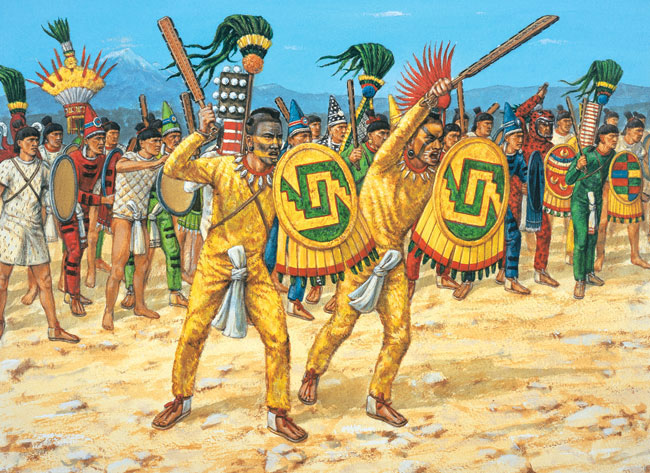Religion
Huitzilopochtli, Place of worship: Teocalli, Gods: Tezcatlipoca, Ehecatl, Quetzalcoatl, Major texts: none, holidays: New FIre ceremony (happens every 52 years and let the fire burn and then another one), The celebration of Vernal Equinox, The festival of Xipe Totec (a god of spring, someone dresses-up as him for 40 days, etc)

Music
Music was an important part of everyday life for the aztecs, who played instruments such as the drums, rattles and flutes. Children between the age of 12 and 15 were expected to know how to sing as well as play songs that were important to the aztec culture. On special occusians, such as sacrifices, a group of Aztecs would play music as the victim would be sacrificed to their gods.

Politics
Religious people were very powerful in the community. Cities are forced to pay tribute to these religious leaders who decided when the city should go to war. Religious people also had access to richer foods compared to the population. These foods included meats, such as ckicken and beef. Religious Leaders also represented the community to other tribes, leading communications as well as well as inter-tribe gatherings.

Economics
The economy was based around the idea of trading, this meant that tribes as well as people would trade goods between eachother in order to obtain necessities such as food and tools. Jobs in this time period mostly involved farming, different farming domains would trade with eachother to have a wider variety of goods.

Slavery
A slave was considered to be anyone who wasn’t represented in the community as middle or higher class. These slaves would not be bound to a particular household, instead they would have to help build temples as well as clean them up. In the aztec culture a large number of slaves would be controlled by the religious leader who would command them to do various tasks. If the Religious Leader though that the number of slaves was too small, he could also command the rest of the population, starting with the middle class to perform jobs.

Daily Life
Daily life in the society of the Aztecs was primarily guided by religious laws. This meant that men were expected to go to war while women stayed at home. Alternatively, a man could also become a farmer or a priest, although warriors were glorified the most. Instead of going to school, aztec children were primarily taught by their parents. At the age of eight, most children would meet at a local building where they would be taught by the elders.

Technology
Maquahuitl is the best known weapon in the Aztec culture. It was similar to sword in addition to having pieces of flint spread around the blade similar to the teeth of a chainsaw.

Food
Typical crops included beans and squash. They typically ate chillies tomatoes, limes, cashews, potatoes, etc... This food was grown on large fields which were managed by "farmers". When found, meat was also eaten, although this was mostly considered a privilege and was reserved for higher classes or special occasions.

Architecture
Primitive tools such as stones, chisels and blades were used to construct the impressive buildings built by the aztecs. Almost all of the architecture in aztec culture relied heavily on astronomy. An important aspect of aztec architecture were the foundations which held the heavy structures known today as the aztec buildings..

Language
Nahun was the primary language for the Aztecs during 600 AD. This language was spoken with 4 vowels. In contrast to many languages used today, this language used heiroglyphs. This trait was very common for many early forms of language and writing, where words were represented using drawings. Over time, these heiroglyphs were symplified to become what we know today as writing.

Sources
http://www.aztec-history.com
http://www.legendsandchronicles.com/ancient-civilizations/the-ancient-aztecs/aztec-architecture/
http://www.legendsandchronicles.com/ancient-civilizations/the-ancient-aztecs/aztec-economy-trade-and-currency/
http://www.aztec-history.com/aztec-temples.html
http://tarlton.law.utexas.edu/aztec-and-maya-law/aztec-social-structure
http://rst61-d2spring2015groupo.weebly.com/aztec-religion.html
http://xxtheaztecempirexx.blogspot.in/2016/02/the-aztecs-had-various-rituals-and.html
http://www.ancient.eu/Xipe_Totec/